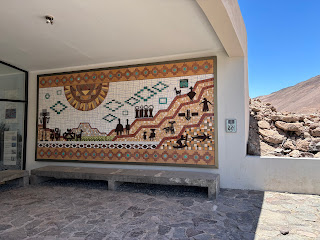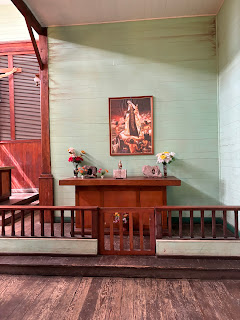 An impressive harbor- the city stretches along the coast and Bam!💥 the sand dune and Atacama desert ( the driest in the world)back up right to the city!
An impressive harbor- the city stretches along the coast and Bam!💥 the sand dune and Atacama desert ( the driest in the world)back up right to the city!
 The port is an open port- means no custom house to collect taxes from ships. I don’t understand how this works…
The port is an open port- means no custom house to collect taxes from ships. I don’t understand how this works…  The city has both falling down buildings and sky scrapers.. many of the buildings are slated for renovation and repairs.
The city has both falling down buildings and sky scrapers.. many of the buildings are slated for renovation and repairs.
 From the port ,we quickly left town on our way to visit an abandoned town where the center for salt petter mining took place. Another name is Sodium Nitrate.. useful for fertilizer and explosives. We are driving through the desert. Iqueque gets zero rainfall a year.. yes you read that right 0! So this desert is really dry as is the entire city. The city gets its water from an aquifer up in the desert areas. Along the road there were small shrines, medium shrines and large ones!
From the port ,we quickly left town on our way to visit an abandoned town where the center for salt petter mining took place. Another name is Sodium Nitrate.. useful for fertilizer and explosives. We are driving through the desert. Iqueque gets zero rainfall a year.. yes you read that right 0! So this desert is really dry as is the entire city. The city gets its water from an aquifer up in the desert areas. Along the road there were small shrines, medium shrines and large ones!  The ghost town of Humberstone is a UNESCO World Heritage Site. At its peak it had 500+workers living and working. The workers were from all over the world, hoping to make improvements to their lives. The truth was they were little more than indentured workers. They were paid in tokens and each mine had their own tokens . Food and anything else for living could only be paid for in tokens at the company store or Mercado. A definite catch 22
The ghost town of Humberstone is a UNESCO World Heritage Site. At its peak it had 500+workers living and working. The workers were from all over the world, hoping to make improvements to their lives. The truth was they were little more than indentured workers. They were paid in tokens and each mine had their own tokens . Food and anything else for living could only be paid for in tokens at the company store or Mercado. A definite catch 22

 The swimming pool- the water was also used to clean and rinse the rocks with minerals so I’m guessing not too clean.. and it’s a giant rusted metal pool!
The swimming pool- the water was also used to clean and rinse the rocks with minerals so I’m guessing not too clean.. and it’s a giant rusted metal pool! The only water fountain in the town . Everyone brought their buckets to fill for their homes.this Mercado was also where they bought fish . For everything else they went to the company store
The only water fountain in the town . Everyone brought their buckets to fill for their homes.this Mercado was also where they bought fish . For everything else they went to the company storeAnd until the 1930’s they were only paid by token.. So they couldn’t go anywhere else.
 The sign reads “Geoglifos de Pintados” a national park dedicated to saving the hillside markings. They think these were road type markers that gave the old civilization notice of where important places were.
The sign reads “Geoglifos de Pintados” a national park dedicated to saving the hillside markings. They think these were road type markers that gave the old civilization notice of where important places were.  A mosaic map of the area at the visitor center. The center wasn’t large but had a concise summary of the people believed to have lived here (1000-300bc) and most importantly, it had shade! We went on a short walk from shaded area to shaded area to view the mountains from afar. No one is allowed close to the geoglyphs trying to prevent them from being vandalized.
A mosaic map of the area at the visitor center. The center wasn’t large but had a concise summary of the people believed to have lived here (1000-300bc) and most importantly, it had shade! We went on a short walk from shaded area to shaded area to view the mountains from afar. No one is allowed close to the geoglyphs trying to prevent them from being vandalized. These were amazing to see. Part of our ship went to another site where there was the largest one found. We chose this tour because of the number available to see. After viewing the. Site, we loaded into the bus to go to a forest preserve of the only tree to live in this desert…I cant remember its name,but as we got close up and personal, I realized it looked terribly familiar…
These were amazing to see. Part of our ship went to another site where there was the largest one found. We chose this tour because of the number available to see. After viewing the. Site, we loaded into the bus to go to a forest preserve of the only tree to live in this desert…I cant remember its name,but as we got close up and personal, I realized it looked terribly familiar… I have this tree in my backyard! Their forest of the only plant that grows in the Atacama dessert is Mesquite! It had the same spines on it, same leaves although a little smaller and the seed pod was similar! What a surprise!
I have this tree in my backyard! Their forest of the only plant that grows in the Atacama dessert is Mesquite! It had the same spines on it, same leaves although a little smaller and the seed pod was similar! What a surprise! Our trip back to town included a much better view of the large sand dune that surrounds the city of Iqueque named the Dragon Dune because from above it looks like a sleeping dragon.
Our trip back to town included a much better view of the large sand dune that surrounds the city of Iqueque named the Dragon Dune because from above it looks like a sleeping dragon.  Our drive into town brought us back to the ship and while refreshing in our stateroom the little head below popped up to welcome us back!
Our drive into town brought us back to the ship and while refreshing in our stateroom the little head below popped up to welcome us back!
































No comments:
Post a Comment